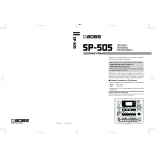
3
Inputting events in rhythm-machine style..........................................30
Drum Grid function........................................................................30
Relationship of Step Time and Grid........................................................................................... 31
Using the Effect.....................................................................................32
Effect (Analog Modeling Bass).....................................................32
Playing from the Effect knobs ..................................................................................................... 32
Playing from a MIDI track/the velocity pads/an external MIDI device ............................. 33
Displaying images ................................................................................34
Outputting images (Pix Jam function).........................................34
Importing images .......................................................................................................................... 34
Switching images by playing the pads ...................................................................................... 35
Switching images in synchronization with sequencer playback ........................................... 35
Saving images together with the project ................................................................................... 36
Performances using V-LINK .........................................................37
Note regarding using the V-LINK.............................................................................................. 37
Using the MV-8000 to operate an external V-LINK device (V-LINK Master) ..................... 37
Using V-LINK from an external device (V-LINK Slave)......................................................... 37
About the V-LINK messages.......................................................................................................38
Other added functions and changes...................................................39
Song................................................................................................39
Recording song or pattern playback to an audio track (Resample Mix) .............................. 39
Loading a song from another project (Load Song) .................................................................. 40
Note event editing in the PIANO ROLL EDIT screen............................................................. 41
Opening the SAMPLE EDIT popup from the AUDIO EVENT PARAMETER popup....... 42
Additions to the Insert Measure function ................................................................................. 43
Additions to the Delete Measure function ................................................................................ 44
Project.............................................................................................45
Sample Manager screen ............................................................................................................... 45
Converting a stereo sample to monaural................................................................................... 46
Saving method of edited sample (Overwrite or Duplicate).................................................... 46
Sound Generator ...........................................................................47
Applying pitches to a partial and assigning them to pads
(Changes in the Set Chromatic function)................................................................................... 47
Additions and changes in the analog input channel parameters .......................................... 47
Adjusting the audio quality when using BPM Sync................................................................ 48
Stopping the sound of currently playing audio phrases and partials................................... 48
Temporarily muting the input audio after sampling .............................................................. 48
Import..............................................................................................49
Importing a patch into a part and library simultaneously...................................................... 49
Pad bank is reset to 1 after importing a patch .......................................................................... 49
Restricting the types of file shown .............................................................................................50
MIDI .................................................................................................51
Playing audio phrases from an external MIDI device ............................................................. 51
MV-8000v3_e.book 3 ページ 2005年11月29日 火曜日 午後5時25分





















